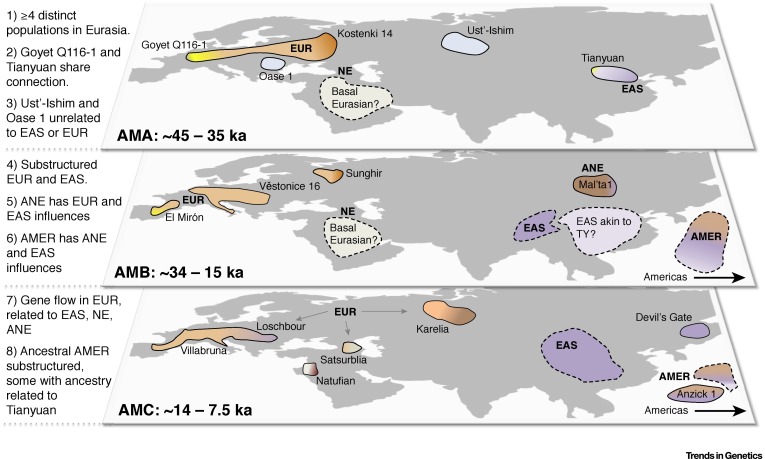Interesting new paper at Science, The earliest modern humans outside Africa, by Hershkovitz et al., Science (2018) Vol. 359, Issue 6374, pp. 456-459
Introduction:
Recent paleoanthropological studies have suggested that modern humans migrated from Africa as early as the beginning of the Late Pleistocene, 120,000 years ago. Hershkovitz et al. now suggest that early modern humans were already present outside of Africa more than 55,000 years earlier (see the Perspective by Stringer and Galway-Witham). During excavations of sediments at Mount Carmel, Israel, they found a fossil of a mouth part, a left hemimaxilla, with almost complete dentition.
The sediments contain a series of well-defined hearths and a rich stone-based industry, as well as abundant animal remains. Analysis of the human remains, and dating of the site and the fossil itself, indicate a likely age of at least 177,000 years for the fossil—making it the oldest member of the Homo sapiens clade found outside Africa.
Abstract
To date, the earliest modern human fossils found outside of Africa are dated to around 90,000 to 120,000 years ago at the Levantine sites of Skhul and Qafzeh. A maxilla and associated dentition recently discovered at Misliya Cave, Israel, was dated to 177,000 to 194,000 years ago, suggesting that members of the Homo sapiens clade left Africa earlier than previously thought. This finding changes our view on modern human dispersal and is consistent with recent genetic studies, which have posited the possibility of an earlier dispersal of Homo sapiens around 220,000 years ago. The Misliya maxilla is associated with full-fledged Levallois technology in the Levant, suggesting that the emergence of this technology is linked to the appearance of Homo sapiens in the region, as has been documented in Africa.
Beautifully complementing this anthropological research, the open access review Insights into Modern Human Prehistory Using Ancient Genomes, by Melinda A. Yang and Qiaomei Fu, Trends in Genetics (2018), depicts potential later migrations:

Abbreviations: AMER, ancestry related to present-day Native Americans and Anzick 1; ANE, ancestry related to ancient North Eurasians represented by Mal’ta 1; EAS, ancestry related to present-day East Asians and the Tianyuan and Devil’s Gate individuals; EUR, ancestry related to ancient Europeans and found partially in present-day Europeans; NE, ancestry related to an unsampled population known as Basal Eurasian and found in partial amounts in ancient and present-day populations of the Near East and in present-day Europeans. Broken lines indicate no ancient genetic samples have been found for a population with the inferred ancestry. Colors loosely indicate genetic groupings between or within a region, with color gradients showing the connections (i.e., gene flow) that may exist between different ancient populations. A summary of major events in each of the time periods is on the left.
Summary:
Eurasia ∼45–35 ka shows the presence of at least four distinct populations: early Asians and Europeans, as well as populations with ancestry found hardly or not at all in present-day populations.
Europeans from around 34–15 ka show high internal population structure.
Approximately 14–7.5 ka, populations across Eurasia shared genetic similarities, suggesting greater interactions between geographically distant populations.
Ancient modern human genomes support at least two Neanderthal admixture events, one ∼60–50 ka in early ancestors of non-African populations and a second >37 ka related to the Oase 1 individual.
A gradual decline in archaic ancestry in Europeans dating from ∼37 to 14 ka suggests that purifying selection lowered the amount of Neanderthal ancestry first introduced into ancient modern humans.
The genetic relationship of past modern humans to today’s populations and each other was largely unknown until recently, when advances in ancient DNA sequencing allowed for unprecedented analysis of the genomes of these early people. These ancient genomes reveal new insights into human prehistory not always observed studying present-day populations, including greater details on the genetic diversity, population structure, and gene flow that characterized past human populations, particularly in early Eurasia, as well as increased insight on the relationship between archaic and modern humans. Here, we review genetic studies on ∼45 000- to 7500-year-old individuals associated with mainly preagricultural cultures found in Eurasia, the Americas, and Africa.
(Both articles discovered via Iosif Lazaridis Twitter account).
See also:
- Optimal Migration Routes of Initial Upper Palaeolithic Populations to Eurasia
- Review article about Ancient Genomics, by Pontus Skoglund and Iain Mathieson
- Review article on the origin of modern humans: the multiple-dispersal model and Late Pleistocene Asia
- Science and Archaeology (Humanities): collaboration or confrontation?
- Massive Migrations? The Impact of Recent aDNA Studies on our View of Third Millennium Europe
- Long-term genetic structure in ancestral Native Americans, consistent with the Beringian ‘standstill model’
- Potential Afroasiatic Urheimat near Lake Megachad